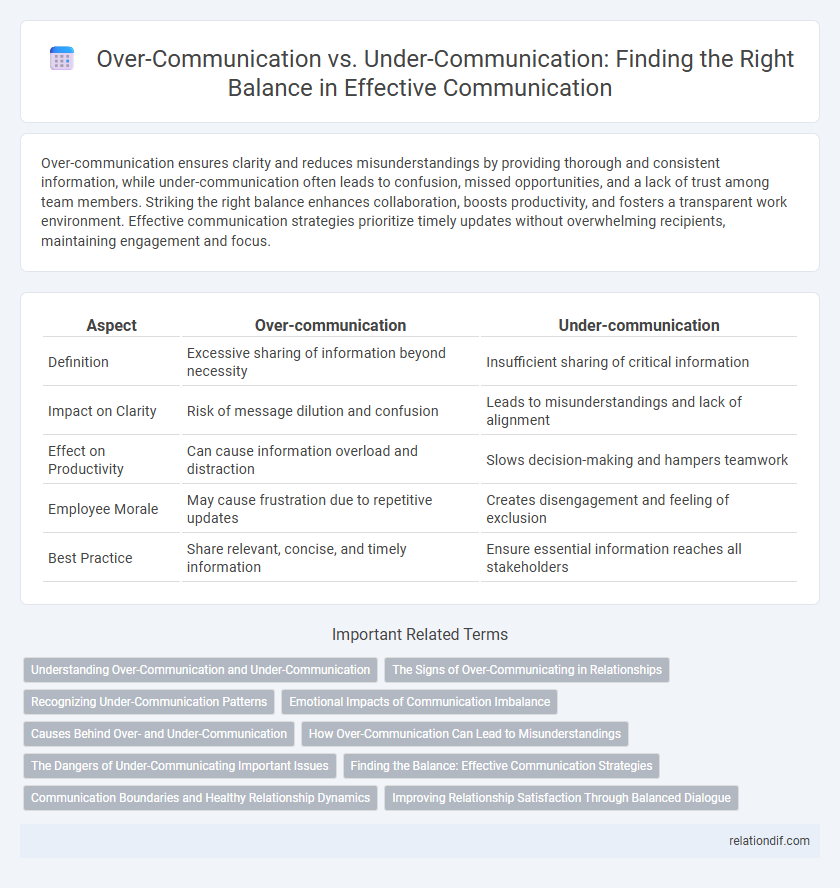Over-communication ensures clarity and reduces misunderstandings by providing thorough and consistent information, while under-communication often leads to confusion, missed opportunities, and a lack of trust among team members. Striking the right balance enhances collaboration, boosts productivity, and fosters a transparent work environment. Effective communication strategies prioritize timely updates without overwhelming recipients, maintaining engagement and focus.
Table of Comparison
| Aspect | Over-communication | Under-communication |
|---|---|---|
| Definition | Excessive sharing of information beyond necessity | Insufficient sharing of critical information |
| Impact on Clarity | Risk of message dilution and confusion | Leads to misunderstandings and lack of alignment |
| Effect on Productivity | Can cause information overload and distraction | Slows decision-making and hampers teamwork |
| Employee Morale | May cause frustration due to repetitive updates | Creates disengagement and feeling of exclusion |
| Best Practice | Share relevant, concise, and timely information | Ensure essential information reaches all stakeholders |
Understanding Over-Communication and Under-Communication
Over-communication involves sharing excessive information that can overwhelm and confuse recipients, leading to misinterpretation and reduced productivity. Under-communication results in insufficient information flow, causing misunderstandings, missed deadlines, and decreased team cohesion. Balancing communication frequency and clarity is critical to ensure effective information exchange and maintain optimal organizational performance.
The Signs of Over-Communicating in Relationships
Excessive messaging or constant check-ins often signal over-communication in relationships, creating feelings of suffocation and irritation. Over-communicating can also manifest through repeated apologies, over-explaining actions, or an inability to respect personal boundaries. Recognizing these signs helps maintain a healthy balance that fosters trust and emotional space.
Recognizing Under-Communication Patterns
Recognizing under-communication patterns is crucial for improving organizational clarity and employee engagement. Common signs include vague instructions, infrequent updates, and a lack of feedback loops, which can lead to misunderstandings and decreased productivity. Addressing these patterns ensures transparent information flow and strengthens team collaboration.
Emotional Impacts of Communication Imbalance
Over-communication can lead to emotional exhaustion, causing stress and frustration due to information overload. Under-communication often results in feelings of isolation, mistrust, and anxiety, as recipients may perceive silence as neglect or uncertainty. Achieving a balanced communication approach fosters emotional well-being by promoting clarity, trust, and connection among individuals.
Causes Behind Over- and Under-Communication
Over-communication often stems from anxiety, lack of trust, or unclear boundaries, leading individuals to share excessive information to ensure understanding or control situations. Under-communication arises from fear of conflict, lack of confidence, or assumptions that others already possess necessary information, resulting in critical details being omitted. Both extremes disrupt effective communication, impacting collaboration and decision-making in organizational and personal contexts.
How Over-Communication Can Lead to Misunderstandings
Excessive messaging and redundant updates in workplace communication can cause information overload, reducing clarity and focus. Over-communication often results in critical details being overlooked or misinterpreted, as recipients struggle to filter relevant content from the noise. Effective communication requires balance to ensure messages are concise, targeted, and facilitate accurate understanding.
The Dangers of Under-Communicating Important Issues
Under-communicating important issues in a workplace leads to misunderstandings, missed deadlines, and a lack of trust among team members. Critical information gaps can cause project failures, decreased employee engagement, and costly errors. Consistent, transparent communication is essential to ensure alignment, improve decision-making, and foster a productive organizational culture.
Finding the Balance: Effective Communication Strategies
Finding the balance between over-communication and under-communication is essential for effective workplace interactions, ensuring messages are clear without overwhelming recipients. Employing active listening techniques and setting communication expectations helps prevent information overload while maintaining transparency. Utilizing tools like concise emails and structured meetings enhances clarity and fosters productive collaboration.
Communication Boundaries and Healthy Relationship Dynamics
Establishing clear communication boundaries helps prevent over-communication, which can lead to information overload and relationship strain, and under-communication, which often causes misunderstandings and emotional distance. Healthy relationship dynamics rely on mutual respect for personal space and timely, transparent exchanges of thoughts and feelings to foster trust and connection. Balancing openness with boundaries encourages effective dialogue and nurtures emotional wellbeing within both personal and professional interactions.
Improving Relationship Satisfaction Through Balanced Dialogue
Balanced dialogue fosters trust and understanding, essential components for improving relationship satisfaction. Over-communication can overwhelm partners, causing stress and misinterpretation, while under-communication leads to feelings of neglect and disconnect. Effective communication strategies emphasize clarity, active listening, and timely sharing of thoughts to maintain emotional intimacy and mutual respect.
over-communication vs under-communication Infographic

 relationdif.com
relationdif.com